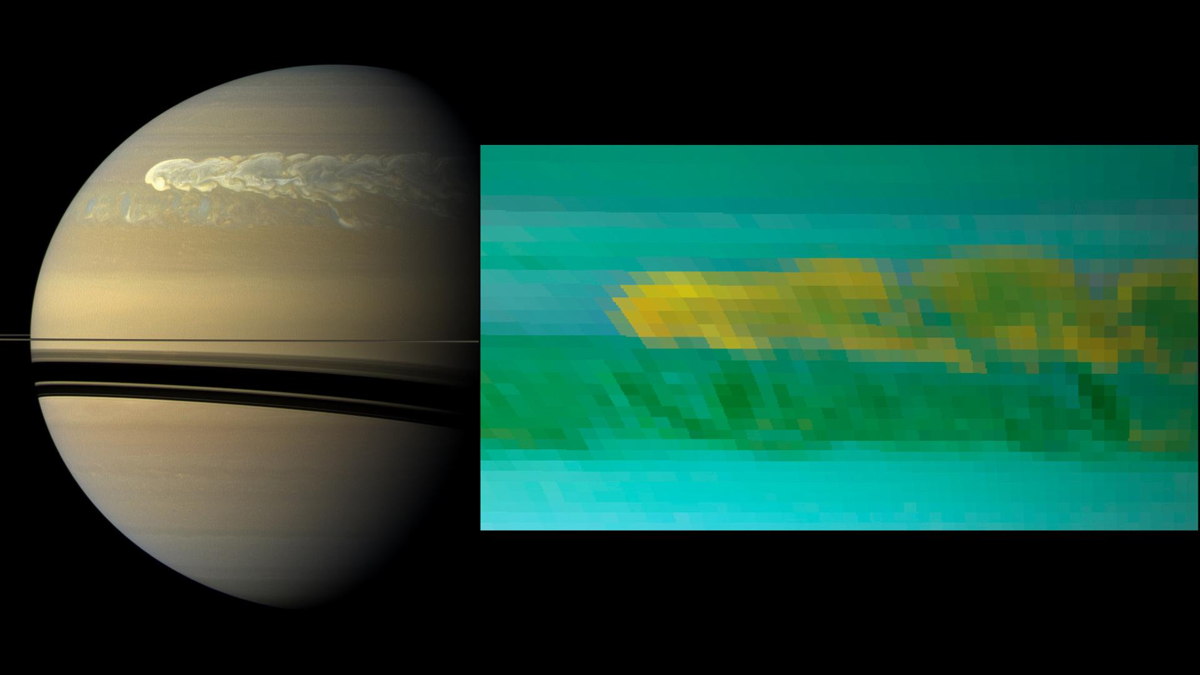Monster Saturn Storm Dredged Up Icy Water from the Deeps

A colossal storm that raged on Saturn in 2010 and 2011 churned water ice up from deep within the ringed planet's thick atmosphere, a new study reports.
NASA's Cassini spacecraft detected the ice crystals from its perch orbiting Saturn. It's the first time water has ever been spotted on the planet, some 400 years after Saturn and its rings were first glimpsed through a telescope.
While water is not a new discovery to a gas giant — Jupiter also has water ice in its atmosphere, for example — the discovery shows just how powerful Saturn storms can be, researchers said. [Photos: Monster Storm Rages on Saturn]
"The new finding from Cassini shows that Saturn can dredge up material from more than 100 miles [160 kilometers]," study co-author Kevin Baines, of the University of Wisconsin and NASA's Jet Propulsion Laboratory in Pasadena, Calif., said in a statement. "It demonstrates in a very real sense that typically demure-looking Saturn can be just as explosive or even more so than typically stormy Jupiter."
Water, water everywhere
The past decade has brought a suite of water-related discoveries in the solar system. On Mars, no less than three NASA rovers and another lander (Phoenix) have come across multiple examples of rocks and features being formed in water in the distant past.
Water ice also exists today at the Martian poles, in permanently shadowed craters on the moon and Mercury and on the surfaces of many satellites in the outer solar system.
Get the Space.com Newsletter
Breaking space news, the latest updates on rocket launches, skywatching events and more!
On Saturn, however, the water ice lay hidden in the atmosphere until a huge storm — part of a pattern that occurs once every 30 years, as far as researchers can tell — began rippling across Saturn's northern hemisphere in December 2010.
The massive Saturn storm grew to a length of about 190,000 miles (300,000 km) — almost 25 times Earth's diameter — making the storm visible even to amateur telescopes on our planet. It eventually fizzled out in August 2011.
The Cassini spacecraft, which has been orbiting Saturn since 2004, gathered data on the storm's cloud composition in February 2011. The observations revealed water ice, ammonia ice and a third unknown substance (possibly ammonium hydrosulfide) sprinkled in particles at the top of the storm.
"The observations are consistent with clouds of different chemical compositions existing side-by-side, though it is more likely that the individual cloud particles are composed of two or all three of the materials," NASA officials wrote in a description of the findings.
Disturbance in the 'sandwich'
Researchers believe Saturn's atmosphere is made up of layers, with water clouds at the bottom, ammonia hydrosulfide just above and then ammonia clouds topping the other two layers. Above this "sandwich" is a hazy layer obscuring everything below it. Scientists still don't know what this top layer is made of.
When the storm began, it tore apart the layers and brought water up from the planet's depths, researchers said. As the water vapor rose higher, it condensed and froze. These crystals also were covered with other materials — ammonium hydrosulfide and ammonia — during the journey through the atmosphere.
"We think this huge thunderstorm is driving these cloud particles upward, sort of like a volcano bringing up material from the depths and making it visible from outside the atmosphere," lead author Lawrence Sromovsky, a planetary scientist at the University of Wisconsin, said in a statement.
"The upper haze is so optically thick that it is only in the stormy regions where the haze is penetrated by powerful updrafts that you can see evidence for the ammonia ice and the water ice. Those storm particles have an infrared color signature that is very different from the haze particles in the surrounding atmosphere," Sromovsky added..
The storm also behaves similarly to those on Earth, the team said in their paper, although Saturn's is on a much grander scale. While Earth storms see convection push air and water vapor into the atmosphere and form thunderstorms, the Saturn storms are 10 to 20 times taller and have winds as fast as 300 mph (500 km/h).
The research was published online in the journal Icarus and will appear in print Sept. 9.
Follow Elizabeth Howell @howellspace. Follow us @Spacedotcom, Facebook or Google+. Originally published on SPACE.com.
Join our Space Forums to keep talking space on the latest missions, night sky and more! And if you have a news tip, correction or comment, let us know at: community@space.com.

Elizabeth Howell (she/her), Ph.D., is a staff writer in the spaceflight channel since 2022 specializing in Canadian space news. She was contributing writer for Space.com for 10 years before joining full-time. Elizabeth's reporting includes multiple exclusives with the White House, speaking several times with the International Space Station, witnessing five human spaceflight launches on two continents, flying parabolic, working inside a spacesuit, and participating in a simulated Mars mission. Her latest book, "Why Am I Taller?" (ECW Press, 2022) is co-written with astronaut Dave Williams.
Most Popular

